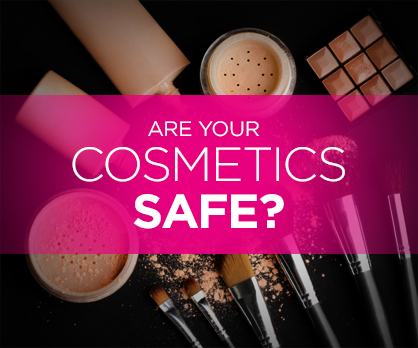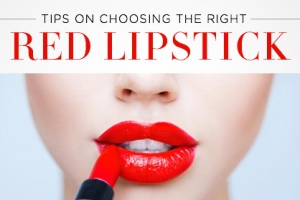What Is Really in Your Cosmetics: 5 Ingredients to Avoid
Cosmetics are some of the least-regulated products on the market, according to the Campaign for Safe Cosmetics. Current federal law permits almost any chemical to be used in personal care products. The $50 billion cosmetic industry is not required to test ingredients or monitor health effects, and lists of ingredients may be misleading or incomplete.
Many believe the government regulates the cosmetic industry to ensure product safety. While the U.S. Food and Drug Administration is the institution that oversee cosmetics, it does not review or approve the vast majority of products or ingredients in cosmetics before they are released for consumer use and has no authority to require pre-market safety testing, unlike with drugs. The FDA declares on its website, “the FDA's legal authority over cosmetics is different from other products regulated by the agency, such as drugs, biologics, and medical devices. Cosmetic products and ingredients are not subject to FDA premarket approval authority.” Fully 89 percent of all ingredients in cosmetics have not been checked for safety by a publicly accountable agency.
The FDA’s website also states “with the exception of color additives and a few prohibited ingredients, a cosmetic manufacturer may use almost any raw material as a cosmetic ingredient and market the product without an approval from FDA.” The FDA allows the cosmetics industry to self-regulate ingredients through its Cosmetics Ingredient Review panel. In 36 years, this panel has only labeled 11 ingredients unsafe, in comparison to the European Union, which has banned hundreds, reports the Environmental Working Group. In addition, cosmetic manufacturers are not required to evaluate the effect of consumers’ cumulative exposures.
All of this points to one key fact: It is up to you to regulate your moisturizer and your lipstick.
Consumers frequently apply cosmetics to the skin. Personal care products are intended to penetrate rather than remain on the skin’s surface. According to an Environmental Working Group study, on average, people use nine products daily, totaling up to 126 unique ingredients. Think about your daily routine: toothpaste, shampoo, deodorant, lipstick, cleanser, mascara, mouthwash, lotion.You need to know exactly what you are ingesting before you buy anything.
When you put on lipstick, spray deodorant or massage in some lotion, you can ingest harmful chemicals into the body. Personal care products typically contain large amounts of chemicals, both natural and synthetic. Although many of these may be benign, some can pose a health hazard and many health risks are unknown.
While more research is needed, it is a safe bet you are putting at least one harmful product into your body. Companies can use ingredients that may cause cancer or are linked to developmental problems, or that are derived from animals, mines or petroleum. Even plant-based ingredients can pose a risk.
The ideal ingredients in cosmetics should be natural ones and not an undefinable list of chemicals. However, products labeled “organic” or “natural” may, in fact, not be all they are cracked up to be because the rules that regulate food are not in effect in cosmetics marketing. Some experts even go so far as to say you should only use products with ingredients you can eat.
Five ingredients to avoid, courtesy of Celeste Hilling, CEO and Founder of Skin Authority
- Mineral Oil: Used as a moisturizer to treat dry or itchy skin, mineral oil can soften and moisturize the skin. Chemically created from petroleum, it can also block the natural elimination abilities of skin cells, plus decreases the body’s ability to cool or heat itself.
- Dyes or Added Color Pigments: Often listed as FD&C (food, drug and cosmetics) and followed by a color designation, these chemically synthesized dyes can be manufactured from coal tar, which may contain traces of metal salt.
- Retinols: One of the animal forms of vitamin A, retinol can be harmful at high levels. It should be avoided while pregnant or nursing. High levels of retinol, such as prescription-based Retin A or Renova, can penetrate the bloodstream and can increase sensitivity to the sun.
- Artificial or Added Fragrances: Often containing more than 100 chemical compounds, artificial fragrances can cause allergic reactions and hormone disruption. Unless all the ingredients are listed on the label, shoppers do not know what is in a certain fragrance. They can also cause headaches and eye sensitivity. Phthalates, probable toxic plasticizing chemicals banned in the European Union, are often hidden under the term “fragrance.”
- Parabens: These petroleum-based preservatives are used to prevent the growth of microbes in cosmetic products. Parabens are linked to cancer, endocrine disruption, reproductive toxicity, immunotoxicity, neurotoxicity and skin irritation. Because they are used to kill bacteria, they have some inherent toxicity. Parabens have been proven to disrupt hormone function, which is linked to increased risk of breast cancer.
For more information, visit the Campaign for Safe Cosmetics or the Environmental Working Group. To peruse safety information on specific cosmetics, visit the Environmental Working Group’s Skin Deep, an online database of about 25,000 personal care products, searchable by brand, ingredient or product type, that compares cosmetic ingredients to more than 50 intentional toxicity databases.
Tagged in: cosmetics, safety, fda, campaign for safe cosmetics, cosmetic safety, safe cosmetics, personal care products, environmental working group,

LadyLUX



